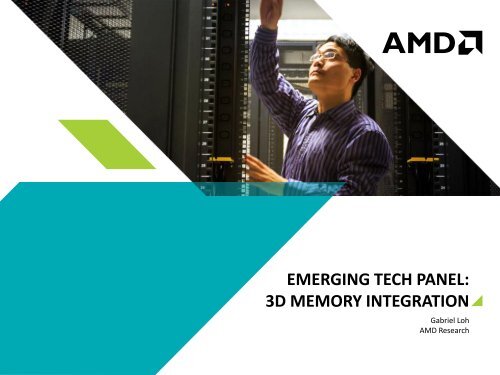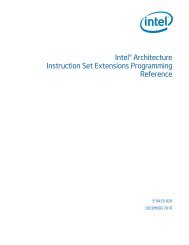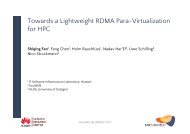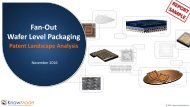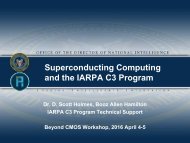IDC_AMD_EmergingTech_Panel
IDC_AMD_EmergingTech_Panel
IDC_AMD_EmergingTech_Panel
You also want an ePaper? Increase the reach of your titles
YUMPU automatically turns print PDFs into web optimized ePapers that Google loves.
EMERGING TECH PANEL:<br />
3D MEMORY INTEGRATION<br />
Gabriel Loh<br />
<strong>AMD</strong> Research
DRAM<br />
DRAM<br />
WHAT IS DIE-STACKING?<br />
xPU<br />
xPU<br />
VERTICAL STACKING (3D)<br />
Interposer<br />
INTERPOSER STACKING (2.5D)<br />
Mix and match different technologies (e.g., CMOS, DRAM)<br />
Replace costly off-package interconnects with short, fast, low-energy in-package<br />
metal routes<br />
Increase integration density<br />
2 | <strong>AMD</strong> RESEARCH | SEPTEMBER, 2014 | --
4 DRAMs<br />
Logic Die<br />
1 ST GENERATION HBM IS SAMPLING!<br />
HTTP://WWW.JEDEC.ORG/STANDARDS-DOCUMENTS/DOCS/JESD235<br />
mBump interface for 2.5D or 3D<br />
8 x 128b Channels<br />
Voltage (I/O, VPP) 1.2V; 2.5V<br />
Data Rate per pin<br />
DRAM Die Density<br />
DRAM Dies per Stack 4<br />
800 – 1.2 MT/s<br />
2Gb<br />
Interface Width 1024<br />
DQs/Channel 128<br />
Channels/Die; Channels/Stack 2; 8<br />
Address/Command Interface<br />
Data Bus Clocking<br />
On Die DLL<br />
Data Bus Termination – On die<br />
Address/Cmd Termination – On<br />
die<br />
DQ Training Mode<br />
Page Size<br />
Banks/Channel 8<br />
DDR<br />
Source synchronous; unidirectional/4byte<br />
No<br />
No<br />
No<br />
N/A<br />
2KB<br />
DRAM Prefetch; Burst Length 256 bits; 2<br />
3 | <strong>AMD</strong> RESEARCH | SEPTEMBER, 2014 | --
Power (W)<br />
Bandwidth (GBps)<br />
IMPROVING BW/WATT WITH DIE-STACKED MEMORY<br />
90<br />
80<br />
70<br />
60<br />
50<br />
40<br />
30<br />
20<br />
10<br />
0<br />
3x<br />
512bG5@8Gbps 4xHBM@1Gbps<br />
DRAM (W) PHY (W) BW<br />
600<br />
500<br />
400<br />
300<br />
200<br />
100<br />
0<br />
Source:<br />
<strong>AMD</strong><br />
Die stacking improves the proximity of the DRAM to Compute<br />
Dense and fine pitch interconnect enables simple low power<br />
interfaces as well as fine grain power control of the DRAM<br />
4 | <strong>AMD</strong> RESEARCH | SEPTEMBER, 2014 | --
WHAT THIS MEANS FOR HPC<br />
In-package memory to deliver high bandwidth<br />
at low power cost<br />
But… in-package memory does<br />
not provide enough capacity<br />
‒ Still need conventional memory<br />
for capacity<br />
Conventional offpackage<br />
memory<br />
Results in a heterogeneous memory<br />
organization/hierarchy<br />
Fast stacked<br />
memory<br />
How does one make small-fast + large-slow memory act like a single, uniform<br />
large+fast memory?<br />
‒ Hardware? Software? Combination?<br />
5 | <strong>AMD</strong> RESEARCH | SEPTEMBER, 2014 | --
PANEL QUESTIONS<br />
Q1: What is most needed to bring to market?<br />
‒ Hardware: technology is there, now need more volume to drive costs/risks down<br />
‒ Software: may be more evolutionary, multiple usage models<br />
Q2: What markets will use it first? Will it be mainstream?<br />
‒ Where bandwidth needs are the highest (GPU)<br />
Q3: What supporting technologies are required?<br />
‒ For wide adoption, software support needs to be there<br />
‒ System software development dependent on hardware availability<br />
‒ Applications optimization dependent on system software, runtimes, libraries, etc.<br />
Q4: What partners would help bring to market sooner?<br />
‒ SoC vendors using more stacked memory volume<br />
‒ Enabled/enhanced by common standards (e.g., JEDEC HBM)<br />
‒ More platforms more software development<br />
6 | <strong>AMD</strong> RESEARCH | SEPTEMBER, 2014 | --
DISCLAIMER & ATTRIBUTION<br />
The information presented in this document is for informational purposes only and may contain technical inaccuracies, omissions and<br />
typographical errors.<br />
The information contained herein is subject to change and may be rendered inaccurate for many reasons, including but not limited to<br />
product and roadmap changes, component and motherboard version changes, new model and/or product releases, product differences<br />
between differing manufacturers, software changes, BIOS flashes, firmware upgrades, or the like. <strong>AMD</strong> assumes no obligation to update or<br />
otherwise correct or revise this information. However, <strong>AMD</strong> reserves the right to revise this information and to make changes from time to<br />
time to the content hereof without obligation of <strong>AMD</strong> to notify any person of such revisions or changes.<br />
<strong>AMD</strong> MAKES NO REPRESENTATIONS OR WARRANTIES WITH RESPECT TO THE CONTENTS HEREOF AND ASSUMES NO RESPONSIBILITY FOR<br />
ANY INACCURACIES, ERRORS OR OMISSIONS THAT MAY APPEAR IN THIS INFORMATION.<br />
<strong>AMD</strong> SPECIFICALLY DISCLAIMS ANY IMPLIED WARRANTIES OF MERCHANTABILITY OR FITNESS FOR ANY PARTICULAR PURPOSE. IN NO<br />
EVENT WILL <strong>AMD</strong> BE LIABLE TO ANY PERSON FOR ANY DIRECT, INDIRECT, SPECIAL OR OTHER CONSEQUENTIAL DAMAGES ARISING FROM<br />
THE USE OF ANY INFORMATION CONTAINED HEREIN, EVEN IF <strong>AMD</strong> IS EXPRESSLY ADVISED OF THE POSSIBILITY OF SUCH DAMAGES.<br />
ATTRIBUTION<br />
© 2014 Advanced Micro Devices, Inc. All rights reserved. <strong>AMD</strong>, the <strong>AMD</strong> Arrow logo and combinations thereof are trademarks of<br />
Advanced Micro Devices, Inc. in the United States and/or other jurisdictions. SPEC is a registered trademark of the Standard Performance<br />
Evaluation Corporation (SPEC). Other names are for informational purposes only and may be trademarks of their respective owners.<br />
7 | <strong>AMD</strong> RESEARCH | SEPTEMBER, 2014 | --


